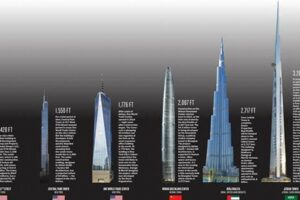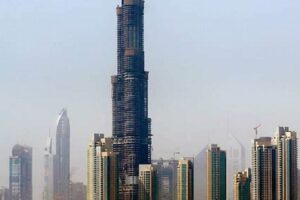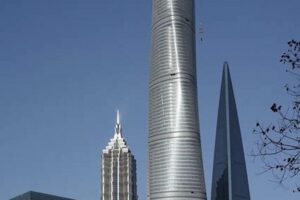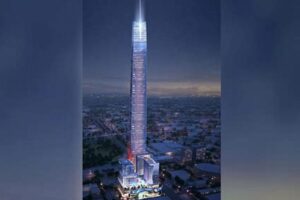The tallest skyscraper in 1910 was the Metropolitan Life Insurance Tower in New York City, standing at 213 meters tall. It was designed by the architectural firm of N. Le Brun & Sons and constructed between 1907 and 1909. The building was a marvel of engineering for its time, featuring a steel frame with a limestone facade and a distinctive clock tower.
The Metropolitan Life Insurance Tower was a significant achievement in skyscraper construction, as it demonstrated the feasibility of building structures over 200 meters tall. It also played a pivotal role in the development of New York City’s skyline, contributing to its reputation as a global center of commerce and finance. The building remains an iconic landmark and a testament to the ingenuity and ambition of its creators.
In the years since the Metropolitan Life Insurance Tower was built, skyscrapers have become increasingly common in major cities around the world. The Burj Khalifa in Dubai, completed in 2010, currently holds the title of the tallest building in the world at 828 meters tall. However, the Metropolitan Life Insurance Tower remains an important historical landmark and a reminder of the pioneering spirit that shaped the early development of skyscrapers.
1. Height
The Metropolitan Life Insurance Tower’s height of 213 meters was a major factor in its designation as the tallest skyscraper in 1910. Prior to its construction, no building had ever exceeded 200 meters in height. The Tower’s height was achieved through the use of a steel frame, which allowed for a lighter and more flexible structure than traditional masonry construction. The Tower’s height also gave it a commanding presence in the New York City skyline, making it a symbol of the city’s growing power and ambition.
The Tower’s height was not merely a matter of aesthetics. It also had practical benefits. The Tower’s upper floors offered tenants panoramic views of the city, which made them highly desirable for businesses and individuals alike. The Tower’s height also allowed it to accommodate more tenants than shorter buildings, making it a more efficient use of land.
The Metropolitan Life Insurance Tower’s height remains an important factor in its legacy. The Tower is still one of the tallest buildings in New York City, and it continues to be a symbol of the city’s architectural heritage. The Tower’s height is a reminder of the pioneering spirit of the early 20th century, when engineers and architects were pushing the boundaries of what was possible in skyscraper construction.
2. Location
New York City’s status as a global hub of commerce and finance played a significant role in the construction of the tallest skyscraper in 1910, the Metropolitan Life Insurance Tower. The city’s booming economy and rapidly growing population created a strong demand for office space, and the Tower’s height allowed it to accommodate a large number of tenants in a relatively small footprint. The Tower’s location in the heart of Manhattan, at the corner of 23rd Street and Madison Square Park, also made it highly desirable for businesses and individuals alike.
- Economic factors: New York City’s strong economy and growing population created a high demand for office space, which contributed to the decision to build the Metropolitan Life Insurance Tower as the tallest skyscraper in 1910.
- Tenant demand: The Tower’s height allowed it to accommodate a large number of tenants in a relatively small footprint, which made it a more efficient use of land and a more profitable investment for the developers.
- Location: The Tower’s location in the heart of Manhattan, at the corner of 23rd Street and Madison Square Park, made it highly desirable for businesses and individuals alike. It was close to transportation hubs, financial institutions, and other important amenities.
- Prestige: Building the tallest skyscraper in the world was a major source of prestige for New York City. It demonstrated the city’s economic power and architectural prowess, and helped to solidify its position as a global center of commerce and finance.
The Metropolitan Life Insurance Tower’s location in New York City was a major factor in its success. The city’s strong economy, growing population, and central location made it an ideal place to build the world’s tallest skyscraper.
3. Architect
N. Le Brun & Sons was the architectural firm responsible for designing the Metropolitan Life Insurance Tower, the tallest skyscraper in 1910. The firm was founded in 1889 by Napoleon Le Brun, a French-born architect who had immigrated to the United States in 1876. Le Brun & Sons quickly became one of the leading architectural firms in New York City, designing a number of notable buildings, including the Singer Building, the Flatiron Building, and the Woolworth Building.
- Design innovation: Le Brun & Sons was known for their innovative designs, which often pushed the boundaries of what was possible in skyscraper construction. The Metropolitan Life Insurance Tower was no exception. The building’s steel frame and limestone facade were both cutting-edge technologies at the time, and the building’s height of 213 meters made it the tallest building in the world.
- Attention to detail: Le Brun & Sons was also known for their attention to detail. The Metropolitan Life Insurance Tower is full of intricate carvings and other decorative elements, which give the building a unique and distinctive look. The building’s lobby is also a work of art, with its marble floors, vaulted ceilings, and stained glass windows.
- Commitment to quality: Le Brun & Sons was committed to building high-quality structures that would stand the test of time. The Metropolitan Life Insurance Tower is a testament to the firm’s commitment to quality. The building has been in continuous use for over 100 years, and it remains one of the most iconic skyscrapers in New York City.
N. Le Brun & Sons played a major role in the design and construction of the Metropolitan Life Insurance Tower, the tallest skyscraper in 1910. The firm’s innovative designs, attention to detail, and commitment to quality are all evident in the building’s design and construction. The Metropolitan Life Insurance Tower is a testament to the firm’s skill and craftsmanship, and it remains one of the most iconic skyscrapers in New York City.
4. Construction
The construction of the Metropolitan Life Insurance Tower from 1907 to 1909 was a crucial factor in its designation as the tallest skyscraper in 1910. The building’s height of 213 meters was a major feat of engineering for its time, and it would not have been possible without the innovative construction techniques and materials used during its construction.
One of the key factors in the Tower’s construction was the use of a steel frame. This was a relatively new technology at the time, and it allowed the building to be built much taller and lighter than would have been possible with traditional masonry construction. The steel frame also allowed for the building’s large windows, which gave tenants panoramic views of the city.
Another important factor in the Tower’s construction was the use of limestone for its facade. Limestone is a durable and fire-resistant material, which helped to protect the building from the elements and from potential fires. The limestone facade also gave the building a distinctive and elegant appearance.
The construction of the Metropolitan Life Insurance Tower was a major undertaking, and it required the collaboration of hundreds of workers. The building’s completion in 1909 was a major milestone in the history of skyscraper construction, and it remains one of the most iconic buildings in New York City today.
5. Style
The Metropolitan Life Insurance Tower, the tallest skyscraper in 1910, was designed in the Beaux-Arts style. Beaux-Arts is a revivalist architectural style that originated in France in the 17th century and was popular in the United States from the late 19th century to the early 20th century. Beaux-Arts architecture is characterized by its grandeur, symmetry, and classical detailing.
- Monumentality: Beaux-Arts buildings are often large and imposing, with a strong sense of verticality. The Metropolitan Life Insurance Tower is a prime example of this, as it stands 213 meters tall and dominates the surrounding cityscape.
- Symmetry: Beaux-Arts buildings are typically symmetrical, with a central axis and matching wings on either side. This creates a sense of balance and order, as seen in the Metropolitan Life Insurance Tower’s facade, which is divided into three vertical sections with the central section being the tallest.
- Classical detailing: Beaux-Arts buildings often incorporate classical architectural elements, such as columns, pediments, and arches. These elements give the buildings a sense of grandeur and sophistication. The Metropolitan Life Insurance Tower features a number of classical details, including a colonnade at the base of the building and a pediment above the main entrance.
The Beaux-Arts style was well-suited for the Metropolitan Life Insurance Tower, as it conveyed the company’s wealth and power. The building’s grandeur and classical detailing also reflected the aspirations of New York City at the turn of the 20th century, as the city was rapidly growing and becoming a major world power.
6. Materials
The Metropolitan Life Insurance Tower, the tallest skyscraper in 1910, was constructed using a steel frame and a limestone facade. These materials played a crucial role in the building’s ability to reach such an unprecedented height and achieve its distinctive architectural style.
- Steel Frame:
The use of a steel frame allowed the building to be built much taller and lighter than would have been possible with traditional masonry construction. Steel is a strong and flexible material that can be used to create long, slender columns and beams. This allowed the architects to create a building that was both structurally sound and visually impressive. - Limestone Facade:
Limestone is a durable and fire-resistant material that was well-suited for the exterior of a tall building. It is also a relatively lightweight material, which helped to reduce the overall weight of the building. The limestone facade gave the building a distinctive and elegant appearance, and it has helped to preserve the building’s exterior over the years.
The combination of a steel frame and a limestone facade allowed the Metropolitan Life Insurance Tower to achieve its status as the tallest skyscraper in 1910. These materials provided the building with the strength, durability, and fire resistance necessary to withstand the challenges of its height and location. They also gave the building a distinctive and elegant appearance that has made it an iconic landmark in New York City.
7. Clock tower
The clock tower of the Metropolitan Life Insurance Tower, the tallest skyscraper in 1910, was a significant architectural feature that served several important functions. Its four-faced clock, illuminated at night, was a prominent landmark that could be seen from miles around. The clock tower also housed a massive bell that rang on the hour, providing a time signal for the surrounding area.
The clock tower was an essential component of the skyscraper’s design. Its height and visibility made it an effective way to advertise the Metropolitan Life Insurance Company and to project an image of strength and stability. The clock tower also served as a practical amenity for the building’s tenants and visitors, providing them with a convenient way to tell the time.
The Metropolitan Life Insurance Tower’s clock tower is a reminder of the importance of public clocks in the early 20th century. Before the widespread adoption of wristwatches, public clocks were essential for people to coordinate their schedules and activities. The clock tower of the Metropolitan Life Insurance Tower was a prominent example of this type of public clock, and it played an important role in the life of New York City.
Today, the clock tower of the Metropolitan Life Insurance Tower remains a popular landmark and a reminder of the building’s historical significance. The clock tower is also a reminder of the important role that public clocks have played in the development of cities and towns.
8. Importance
The Metropolitan Life Insurance Tower’s status as the first skyscraper over 200 meters tall was a significant achievement in the history of architecture and engineering. It represented a major milestone in the development of skyscrapers and set a new standard for building height. The Tower’s height allowed it to dominate the New York City skyline and become a symbol of the city’s power and ambition.
- Engineering innovation: The Tower’s height was made possible by a number of innovative engineering techniques, including the use of a steel frame and a limestone facade. These techniques allowed the building to be built to a height that was previously impossible.
- Architectural impact: The Tower’s height and distinctive design had a major impact on the architecture of skyscrapers. It inspired other architects to design even taller buildings, and it helped to establish the skyscraper as a dominant feature of the urban landscape.
- Symbol of progress: The Tower’s height was seen as a symbol of progress and ambition. It represented the city’s growing wealth and power, and it helped to create a sense of optimism about the future.
The Metropolitan Life Insurance Tower’s status as the first skyscraper over 200 meters tall was a major achievement that had a profound impact on the development of skyscrapers and the architecture of cities. It remains a symbol of the power and ambition of New York City and a reminder of the ingenuity of the engineers and architects who designed and built it.
9. Legacy
The Metropolitan Life Insurance Tower’s legacy as an iconic landmark and symbol of New York City’s skyline is inextricably linked to its status as the tallest skyscraper in 1910. The Tower’s height and distinctive design made it an instant landmark, and its central location in Manhattan ensured that it would become a defining feature of the city’s skyline. Over the years, the Tower has been featured in countless photographs, films, and television shows, and it has become one of the most recognizable buildings in the world.
The Tower’s status as an iconic landmark has also contributed to its importance as a symbol of New York City’s skyline. The Tower’s height and grandeur represent the city’s power and ambition, and it has become a symbol of the city’s resilience and spirit. The Tower has also been used as a symbol of hope and progress, and it has been featured in many campaigns to promote New York City and its values.
The Tower’s legacy as an iconic landmark and symbol of New York City’s skyline is a testament to its enduring appeal and significance. The Tower is a reminder of the city’s rich history and its architectural heritage, and it continues to be a source of pride for New Yorkers and visitors alike.
FAQs about the Tallest Skyscraper in 1910
The Metropolitan Life Insurance Tower, completed in 1909, held the title of the world’s tallest skyscraper for two years. Here are the answers to some frequently asked questions about this architectural marvel:
Question 1: How tall is the Metropolitan Life Insurance Tower?
The Metropolitan Life Insurance Tower stands at 213 meters (700 feet) tall.
Question 2: How many floors does the Metropolitan Life Insurance Tower have?
The Metropolitan Life Insurance Tower has 50 floors.
Question 3: What architectural style is the Metropolitan Life Insurance Tower?
The Metropolitan Life Insurance Tower is designed in the Beaux-Arts style, characterized by its grandeur, symmetry, and classical detailing.
Question 4: Who was the architect of the Metropolitan Life Insurance Tower?
The Metropolitan Life Insurance Tower was designed by the architectural firm N. Le Brun & Sons.
Question 5: What materials were used to construct the Metropolitan Life Insurance Tower?
The Metropolitan Life Insurance Tower was constructed using a steel frame and a limestone facade.
Question 6: What is the significance of the Metropolitan Life Insurance Tower?
Completed in 1909, the Metropolitan Life Insurance Tower marked a significant milestone in the history of skyscraper construction, demonstrating the feasibility of constructing buildings over 200 meters tall. It also played a crucial role in shaping the New York City skyline, solidifying the city’s status as a global center of commerce and finance.
These FAQs provide a brief overview of the Metropolitan Life Insurance Tower, its architectural significance, and its lasting impact on the skyline of New York City. For further exploration, refer to the comprehensive article on the topic provided below.
Transition to the next article section:
Explore the Metropolitan Life Insurance Tower in Depth
Tips Related to the Tallest Skyscraper in 1910
The Metropolitan Life Insurance Tower, completed in 1909, marked a significant milestone in the history of skyscraper construction. Here are some valuable tips related to this architectural marvel and its legacy:
Tip 1: Appreciate its architectural significance: The Metropolitan Life Insurance Tower is an embodiment of the Beaux-Arts architectural style, characterized by its grandeur, symmetry, and classical detailing. Its design showcases the transition from traditional masonry construction to the use of steel frames in skyscraper construction.
Tip 2: Explore its historical context: The construction of the Metropolitan Life Insurance Tower coincided with New York City’s rapid growth and transformation into a global metropolis. Understanding the historical context of its construction provides insights into the city’s architectural evolution and its status as a major financial and commercial hub.
Tip 3: Visit the building to experience its grandeur: If you have the opportunity, visit the Metropolitan Life Insurance Tower to appreciate its architectural details up close. Take a guided tour to learn more about its history, construction, and significance in the development of skyscrapers.
Tip 4: Explore related architectural landmarks: New York City is home to many other iconic skyscrapers and architectural landmarks. Visit neighboring buildings like the Flatiron Building or the Empire State Building to gain a comprehensive understanding of the city’s architectural heritage and the evolution of skyscraper design.
Tip 5: Learn about the impact of skyscrapers: The construction of skyscrapers has significantly shaped urban landscapes and influenced city planning. Research the impact of skyscrapers on urban development, sustainability, and the overall transformation of cities.
Tip 6: Stay informed about the latest skyscraper developments: The field of skyscraper construction is constantly evolving with new technologies and design concepts. Stay informed about the latest trends and innovations in skyscraper design and construction to appreciate the ongoing evolution of this architectural typology.
Tip 7: Draw inspiration from its enduring legacy: The Metropolitan Life Insurance Tower stands as a testament to human ingenuity and the pursuit of architectural excellence. Draw inspiration from its enduring legacy and apply its principles to your own endeavors, whether in architecture, design, or any other field.
Tip 8: Promote architectural preservation: Historic buildings like the Metropolitan Life Insurance Tower are valuable cultural assets that contribute to the identity and character of a city. Support efforts aimed at preserving and protecting architectural heritage to ensure that future generations can appreciate and learn from these iconic structures.
By following these tips, you can deepen your understanding of the tallest skyscraper in 1910, the Metropolitan Life Insurance Tower, and appreciate its architectural significance and lasting impact on the urban landscape.
Conclusion:
The Metropolitan Life Insurance Tower remains a beacon of architectural achievement and a symbol of New York City’s architectural heritage. Its story and legacy continue to inspire and inform architects, engineers, and urban planners worldwide. By embracing the tips outlined above, you can gain a deeper appreciation for this architectural marvel and its enduring contributions to the field of skyscraper construction.
Conclusion
The exploration of the tallest skyscraper in 1910, the Metropolitan Life Insurance Tower, unveils a captivating tale of architectural innovation and urban transformation. This iconic structure not only redefined the skyline of New York City but also set a new benchmark for skyscraper construction.
The Tower’s legacy extends beyond its physical presence. It serves as a testament to the ingenuity and ambition that drove the early 20th-century architectural landscape. Its impact on the field of skyscraper design is undeniable, inspiring countless architects and engineers to push the boundaries of vertical construction.
As we reflect on the architectural marvel of the Metropolitan Life Insurance Tower, we are reminded of the enduring power of human creativity and the transformative role that buildings play in shaping urban environments. May this exploration inspire future generations to continue innovating and striving for architectural excellence.







